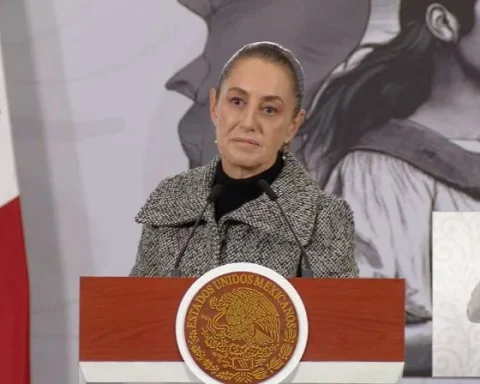While the votes still need to be counted in some states, the general result of the midterm election in the United States shows that the Republicans have won the majority in the House of Representatives, but by a smaller margin than expected, and at the end of this column are still tied at 48 senators. As much as the patriotic electorate has mobilized, while the woke remained at home, the candidates supported by former President Donald Trump have obtained fewer victories than expected and the powerful conservative victories in Texas and Florida have consecrated alternative leaderships among the reds. . In general, the picture points to a shift towards the center. It gives the impression that, faced with the urgency to solve the economic and social problems, the voters have opted for ideological moderation. In a world scenario in which the US is the only Western power to emerge unscathed from the crisis and the war, this consolidation of the dominant bloc would allow a speedy recovery of the superpower.
It was a better-than-expected night for Democrats, who gasped as it became clear that the Republican “red wave” predicted by some pundits and polls had failed to materialize. At the gubernatorial level, the races that had given Democrats some last-minute jitters were won handily by Michigan Governor Gretchen Whitmer and New York Governor Kathy Hochul.
On the Republican side, Ron DeSantis swept Florida. He was expected to be re-elected to a second term, but the 20-point lead he gained over his Democratic opponent propelled him to national stardom. Four years ago DeSantis won the governorship by less than a point and former President Trump won the Sunshine State two years ago by about three points. Now, without the support of the former president, the governor multiplied the advantage.
Also in Florida, Sen. Marco Rubio (R) scored an easy win over Rep. Val Demings (D). Given the magnitude of these two victories, it is clear that Florida is now a red state. For decades it counted in pre-election calculations as a “pendulum state” that could swing between the two parties, but this idea is a thing of the past.
In Pennsylvania, meanwhile, Dr. Mehmet Oz, chosen by Trump to represent the Republican Party, lost to Lieutenant Governor John Fetterman. He had suffered a stroke earlier in the contest, but, despite his limited mobility, he beat the TV doctor. The victory in Pennsylvania gives a big boost to the Democrats. This victory demonstrated that the candidate’s brand of progressive populism could prevail even on one of the most divided battlefields in the country.
In New Hampshire, meanwhile, incumbent Sen. Maggie Hassan defended her seat against Gen. Dan Bolduc, another Trump candidate with little political experience. Bolduc was a risky bet that did not have the support of the Republican apparatus, although in recent weeks he has come close to the goal.
In Arizona, similarly, Senate candidate Blake Masters (another Trump pick) lost to Democratic incumbent Mark Kelly. Masters is also a political neophyte who has come back in recent weeks. He was supported by another Trump acolyte, gubernatorial candidate Kari Lake, also defeated by Democrat Katie Hobbs.
True, in Ohio, JD Vance, another Trump man, won against Democrat Tim Ryan, and in Georgia, Hershel Walker, also backed by the former president, forced incumbent Raphael Warnock into a runoff. But both Senate candidates were aided by popular governors who propelled them to victory. In short: there was no “red wave”.
The biggest winner of the midterm elections was without a doubt Ron DeSantis. The biggest loser was Donald Trump. Many will conclude, based on the results of this midterm election, that the Republican Party is ready to move on without Donald Trump as its leader. However, although Donald Trump has faded as the patriotic and reactionary alternative that he knew how to represent, he is going to put up a fierce fight for the presidential candidacy in 2024. Almost two years after his re-election defeat, he remains the most popular and influential politician of the Republican Party and also the most successful fundraiser, with immense influence over legions of grassroots donors. And poll after poll indicates that Trump would start out as the overwhelming favorite for the GOP nomination.
Democrats must have seen the results as the most they could get, but two gubernatorial losses hit them hard: Stacey Abrams (Democrat) lost in Georgia to Gov. Brian Kemp (Republican) and former Rep. Beto O’Rourke (Democrat) fell to Gov. Greg Abbott in Texas.
The US has the worst inflation in four decades (9.1%), the worst drop in real wages in 40 years, the worst crime wave since the 1990s, the worst border crisis in US history, you have Joe Biden, who is the least popular president since Harry Truman, and there was no red tide. What happened?
Neither party appreciated the state of mind of the population in its fair measure. Clouded by the competition between the candidates for 2024, the Trumpists wanted to eat dessert before sitting down at the table and the conservative party apparatus withdrew its support in many of the key fights. Tired of the shadow boxing imposed by political correctness and stunned by the shameful spectacle that the president puts on, the Democrats did not play too much either.
It was the voters who were at the forefront of the decision. While the rural rather than urban vote and high-income deciles rather than low-income deciles swung Republican, the conservative shift was also among African-Americans and Hispanics, as well as among women and gender minorities . In general, a slight inclination towards the color red prevailed, but the movement has not brought any change. Rather, the voters have made a warning and a claim to the political class: put aside the ideological struggle and solve the concrete problems.

The shift of representation towards the center validates the established power of both partisan apparatuses, Justice, the media, finance, security and intelligence services, as well as the armed forces, in short, the establishment. If they reach a grand cross-party deal, they can implement Biden’s green transition and infrastructure plan, putting themselves at the forefront of electric mobility in the West. German industry has already slowed down, for this they have the enormous mass of financial capital absorbed in recent months thanks to the rise in interest rates, the cheap energy provided by the exploitation of shale oil and gas, the availability of a gigantic mass from the demographic growth of the 2000s and from immigration and, finally, they also have (along with Canada) diplomatic and military control over strategic minerals in East Africa, as well as over lithium in Argentina and Chile. If they agree to develop electric mobility, they will start a virtuous cycle like the 20th century Fordist. If, on the other hand, they put their ideological blinders before them and prolong the internal fracture, they will enter into an endless cycle of fratricidal struggles and retreat from the competing powers.

















